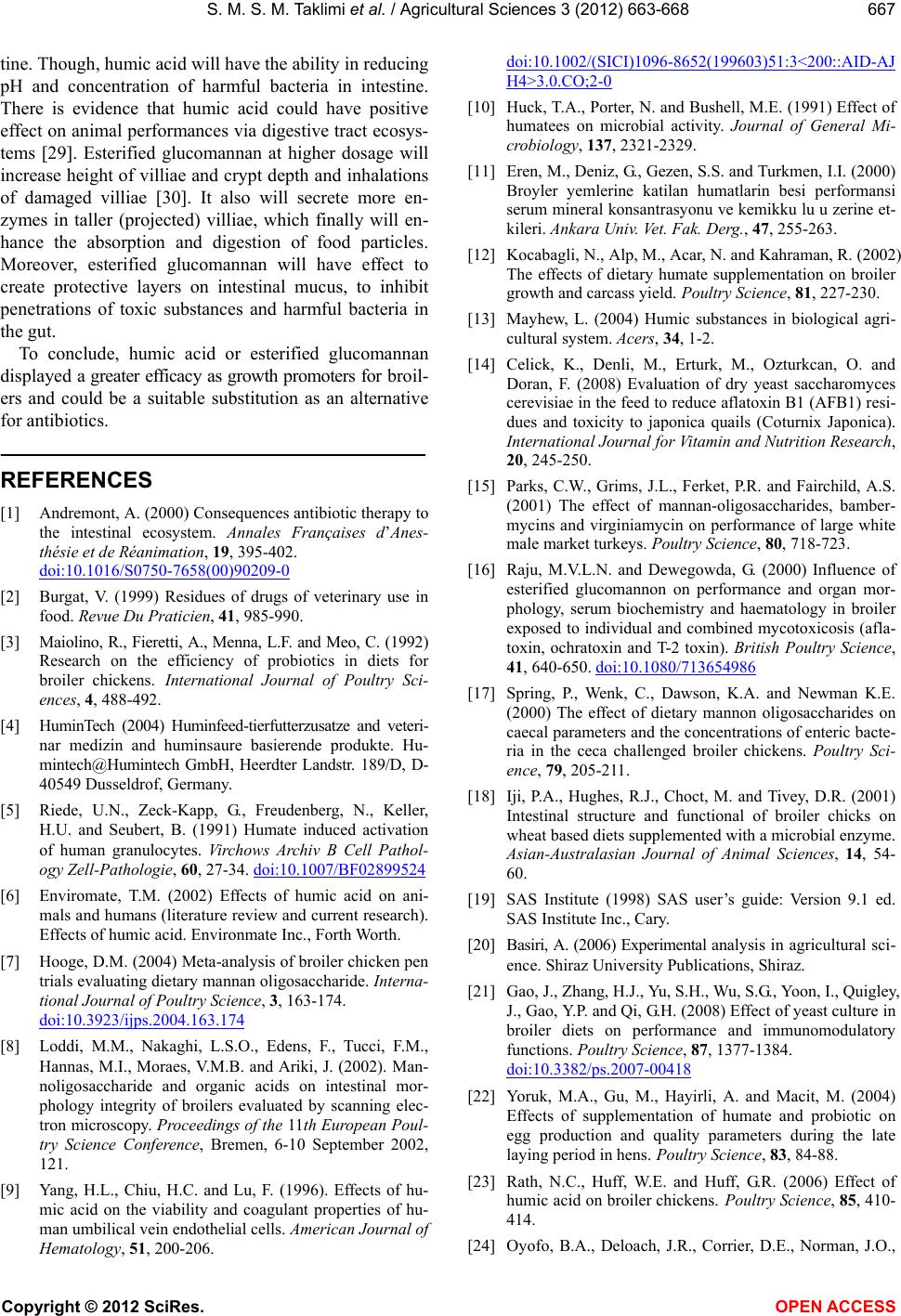
S. M. S. M. Taklimi et al. / Agricultural Sciences 3 (2012) 663-668 667
tine. Though, humic acid will have the ability in reducing
pH and concentration of harmful bacteria in intestine.
There is evidence that humic acid could have positive
effect on animal performances via digestive tract ecosys-
tems [29]. Esterified glucomannan at higher dosage will
increase height of villiae and crypt depth and inhalations
of damaged villiae [30]. It also will secrete more en-
zymes in taller (projected) villiae, which finally will en-
hance the absorption and digestion of food particles.
Moreover, esterified glucomannan will have effect to
create protective layers on intestinal mucus, to inhibit
penetrations of toxic substances and harmful bacteria in
the gut.
To conclude, humic acid or esterified glucomannan
displayed a greater efficacy as growth promoters for broil-
ers and could be a suitable substitution as an alternative
for antibiotics.
REFERENCES
[1] Andremont, A. (2000) Consequences antibiotic therapy to
the intestinal ecosystem. Annales Françaises d’Anes-
thésie et de Réanimation, 19, 395-402.
doi:10.1016/S0750-7658(00)90209-0
[2] Burgat, V. (1999) Residues of drugs of veterinary use in
food. Revue Du Praticien, 41, 985-990.
[3] Maiolino, R., Fieretti, A., Menna, L.F. and Meo, C. (1992)
Research on the efficiency of probiotics in diets for
broiler chickens. International Journal of Poultry Sci-
ences, 4, 488-492.
[4] HuminTech (2004) Huminfeed-tierfutterzusatze and veteri-
nar medizin and huminsaure basierende produkte. Hu-
mintech@Humintech GmbH, Heerdter Landstr. 189/D, D-
40549 Dusseldrof, Germany.
[5] Riede, U.N., Zeck-Kapp, G., Freudenberg, N., Keller,
H.U. and Seubert, B. (1991) Humate induced activation
of human granulocytes. Virchows Archiv B Cell Pathol-
ogy Zell-Pathologie, 60, 27-34. doi:10.1007/BF02899524
[6] Enviromate, T.M. (2002) Effects of humic acid on ani-
mals and humans (literature review and current research).
Effects of humic acid. Environmate Inc., Forth Worth.
[7] Hooge, D.M. (2004) Meta-analysis of broiler chicken pen
trials evaluating dietary mannan oligosaccharide. Interna-
tional Journal of Poultry Science, 3, 163-174.
doi:10.3923/ijps.2004.163.174
[8] Loddi, M.M., Nakaghi, L.S.O., Edens, F., Tucci, F.M.,
Hannas, M.I., Moraes, V.M.B. and Ariki, J. (2002). Man-
noligosaccharide and organic acids on intestinal mor-
phology integrity of broilers evaluated by scanning elec-
tron microscopy. Proceedings of the 11th European Poul-
try Science Conference, Bremen, 6-10 September 2002,
121.
[9] Yang, H.L., Chiu, H.C. and Lu, F. (1996). Effects of hu-
mic acid on the viability and coagulant properties of hu-
man umbilical vein endothelial cells. American Journal of
Hematology, 51, 200-206.
doi:10.1002/(SICI)1096-8652(199603)51:3<200::AID-AJ
H4>3.0.CO;2-0
[10] Huck, T.A., Porter, N. and Bushell, M.E. (1991) Effect of
humatees on microbial activity. Journal of General Mi-
crobiology, 137, 2321-2329.
[11] Eren, M., Deniz, G., Gezen, S.S. and Turkmen, I.I. (2000)
Broyler yemlerine katilan humatlarin besi performansi
serum mineral konsantrasyonu ve kemikku lu u zerine et-
kileri. Ankara Univ. Vet. Fak. Derg., 47, 255-263.
[12] Kocabagli, N., Alp, M., Acar, N. and Kahraman, R. (2002)
The effects of dietary humate supplementation on broiler
growth and carcass yield. Poultry Science, 81, 227-230.
[13] Mayhew, L. (2004) Humic substances in biological agri-
cultural system. Acers, 34, 1-2.
[14] Celick, K., Denli, M., Erturk, M., Ozturkcan, O. and
Doran, F. (2008) Evaluation of dry yeast saccharomyces
cerevisiae in the feed to reduce aflatoxin B1 (AFB1) resi-
dues and toxicity to japonica quails (Coturnix Japonica).
International Journal for Vitamin and Nutrition Research,
20, 245-250.
[15] Parks, C.W., Grims, J.L., Ferket, P.R. and Fairchild, A.S.
(2001) The effect of mannan-oligosaccharides, bamber-
mycins and virginiamycin on performance of large white
male market turkeys. Poultry Science, 80, 718-723.
[16] Raju, M.V.L.N. and Dewegowda, G. (2000) Influence of
esterified glucomannon on performance and organ mor-
phology, serum biochemistry and haematology in broiler
exposed to individual and combined mycotoxicosis (afla-
toxin, ochratoxin and T-2 toxin). British Poultry Science,
41, 640-650. doi:10.1080/713654986
[17] Spring, P., Wenk, C., Dawson, K.A. and Newman K.E.
(2000) The effect of dietary mannon oligosaccharides on
caecal parameters and the concentrations of enteric bacte-
ria in the ceca challenged broiler chickens. Poultry Sci-
ence, 79, 205-211.
[18] Iji, P.A., Hughes, R.J., Choct, M. and Tivey, D.R. (2001)
Intestinal structure and functional of broiler chicks on
wheat based diets supplemented with a microbial enzyme.
Asian-Australasian Journal of Animal Sciences, 14, 54-
60.
[19] SAS Institute (1998) SAS user’s guide: Version 9.1 ed.
SAS Institute Inc., Cary.
[20] Basiri, A. (2006) Experimental analysis in agricultural sci-
ence. Shiraz University Publications, Shiraz.
[21] Gao, J., Zhang, H.J., Yu, S.H., Wu, S.G., Yoon, I., Quigley,
J., Gao, Y.P. and Qi, G.H. (2008) Effect of yeast culture in
broiler diets on performance and immunomodulatory
functions. Poultry Science, 87, 1377-1384.
doi:10.3382/ps.2007-00418
[22] Yoruk, M.A., Gu, M., Hayirli, A. and Macit, M. (2004)
Effects of supplementation of humate and probiotic on
egg production and quality parameters during the late
laying period in hens. Poultry Science, 83, 84-88.
[23] Rath, N.C., Huff, W.E. and Huff, G.R. (2006) Effect of
humic acid on broiler chickens. Poultry Science, 85, 410-
414.
[24] Oyofo, B.A., Deloach, J.R., Corrier, D.E., Norman, J.O.,
Copyright © 2012 SciRes. OPEN ACCESS